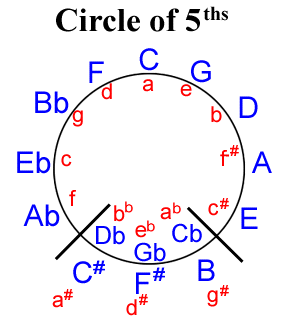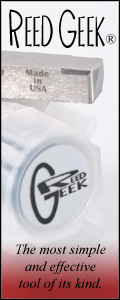Theory 2 – KeysNow on to keys. Like I mentioned on page one, there are only twelve notes. For each of those twelve notes, there is a corresponding major key. For each of those major keys, there is a relative minor key. They both share the same key signature. I explain to my students that major is a bright and cheerful sound, while minor is a dark and somber sound. Be sure to read lesson forty four on the lessons page for an explanation of how to construct a major and minor scale. This twelve tone system was developed as a way to divide the octave into twelve equal parts. This is known as the tempered scale. While not mathematically correct, it is a way to make each key relatively equal. J.S. Bach wrote “The Well Tempered Clavier” to investigate the differences in each key which he called “key feeling.” |
| Here is what is called the circle of fifths. On the outside are the major keys. On the inside are the relative minor keys. As you go around clockwise, you go up in fifths. In other words, the fifth degree of the C major scale is G. The fifth degree of the G major scale is D, etc. If you go around counter clockwise, you go up in fourths. In other words, the fourth degree of C, is F. The fourth degree of the F major scale is B flat, etc.
Key signatures are what we use to identify these keys. Sharps and flats are always in the same order. They always appear right next to the clef sign, before the time signature. There is a little trick that will make key signature recognition easier. In the flat keys, this works in every key except for the key of F, which has one flat (b flat). With two flats or more, just say the name of the second to the last flat and that’s the key you’re in. Either major or the relative minor of that key. For sharp keys, say the name of the note a half step up from the last sharp and that’s the key you’re in. Either major or the relative minor of that key. Another helpful hint is to know that every flat key except for F and C, has the word “flat” in it. If the key doesn’t have the word “flat” in it, it is a sharp key, (except F and C). |
Search saxlessons.com
If you found this site helpful, please donate.






